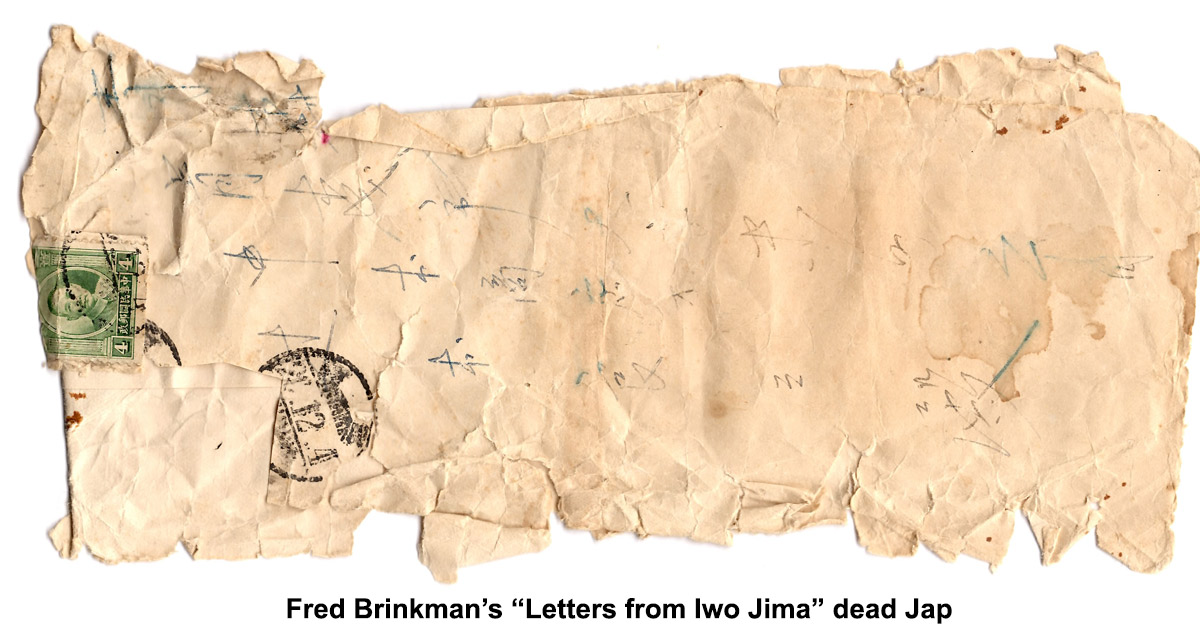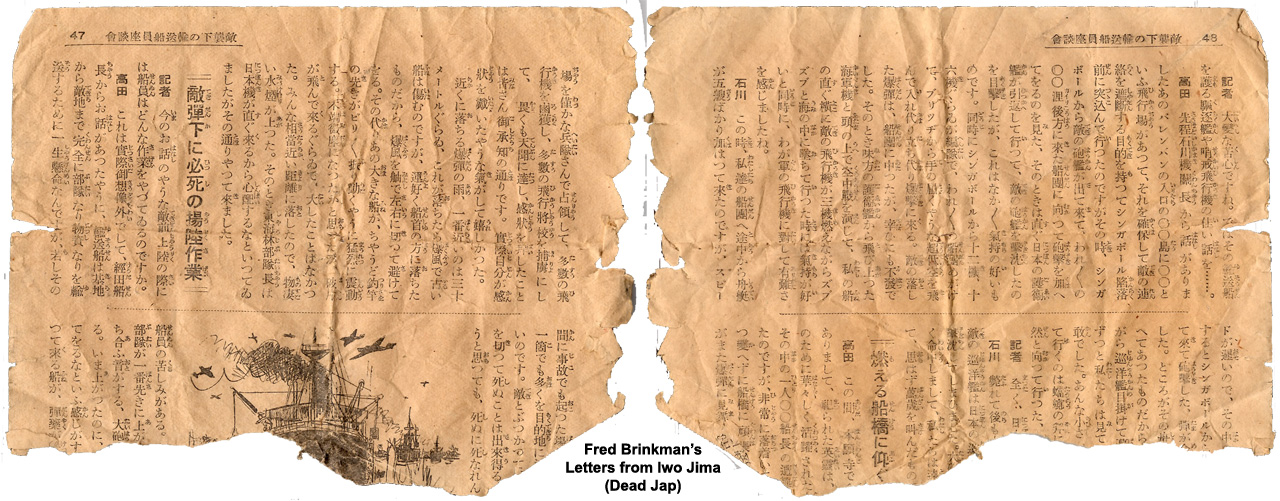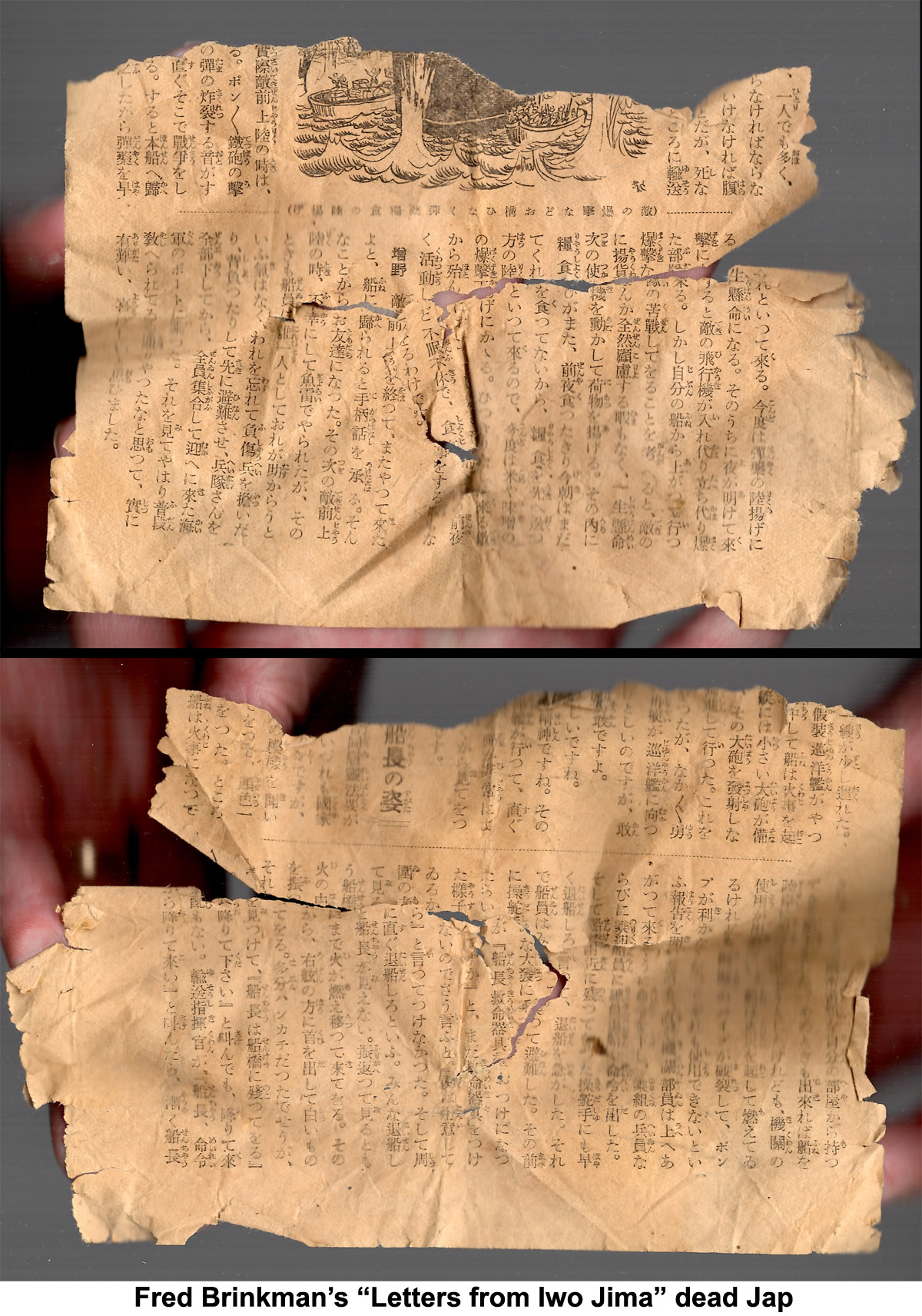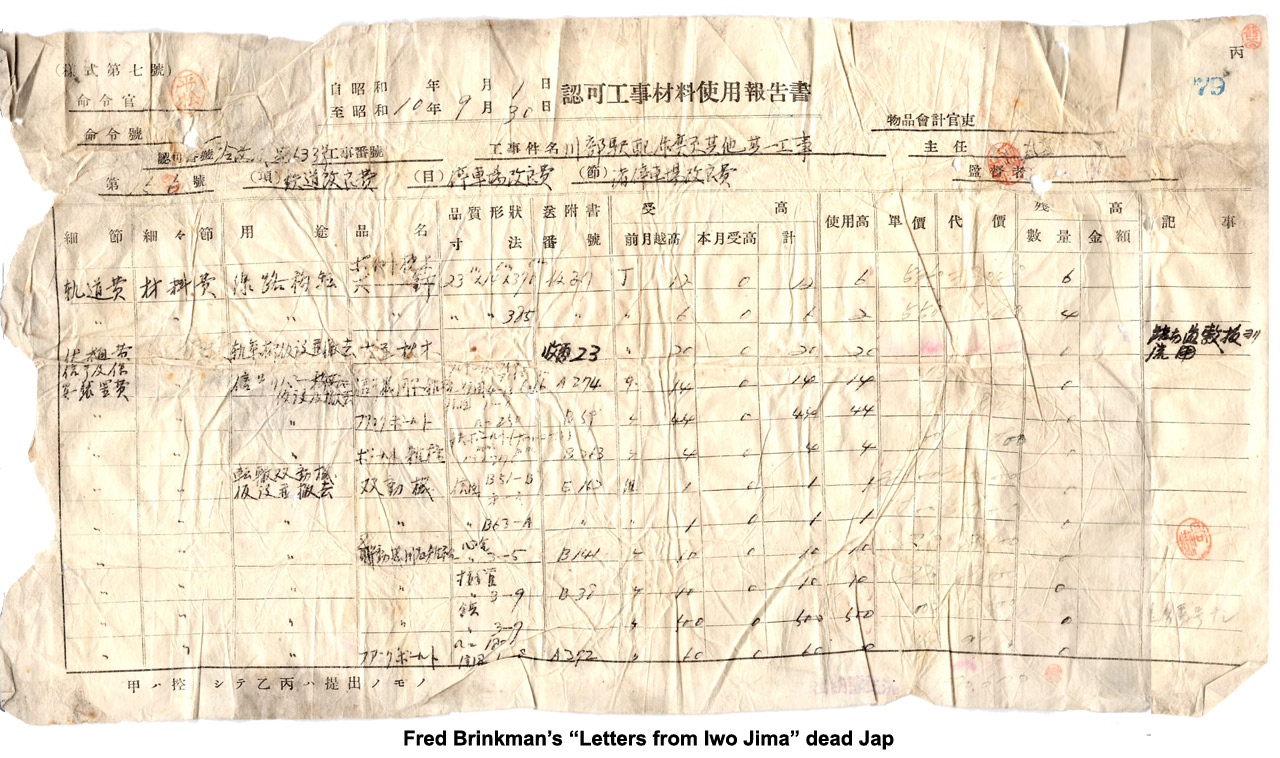Letters From Iwo Jima
From
the book "Attack Transport: Iwo Jima. The USS Lowndes": While rummaging
through boxes in my family's attic, I would discover a box of items
from another era. Photo albums revealed they were from the time my
father (Fred Brinkman) served in WWII. Among the items were medical
tools and a bottle of black sand with "Iwo Jima" written on it. There
were also handwritten Japanese letters and other Japanese documents.
And, in a small box, I was stunned to discover a gold tooth with the
full root. There were also dog tags of two Beach Party members who
were killed in the Iwo Jima battle. An envelope, date stamped 1945, San
Francisco, contained a 40-page letter that my father had written to his
father. The letter detailed my dad's experience as a Navy Corpsman in a
Beach party during the initial invasion of Iwo Jima. I would never be
able to erase from my mind the horrific images drawn by my father's
account. Respectful of my dad's silence on the ordeal, I never asked
questions, but many years later, I jumped on the opportunity to attend
a reunion of his father's shipmates. Just months after the reunion, my
father was diagnosed with cancer and died within a few months. To honor
him, my family and I would attend the reunions each year. Through these
experiences, we discovered the greatest generation that has ever lived.
These Americans (on the home and war fronts) saved the world. One thing
would lead to another, and I became the historian for the reunion
group. I would find many missing sailors and solve many significant
mysteries. But, there are still mysteries to be solved..

To understand the full story, you need to read Fred Brinkman's letter. The dog tags belonging to Don Bowman and Norman Richards were returned to the families. The piece of concrete was from the battered Japanese pillbox, which the Lowndes Beach Party members used to partially shield themselves from enemy mortor and sniper fire. Despite this bit of protection and the use of foxholes, many of the Beach Party members were still wounded or killed.
This web page looks at the documentation that Fred Brinkman took from the dead Japanese soldier who killed Donald Bowman. It includes a personal letter, newspaper clippings, and a military document. Future work (translations and DNA of the soldier's tooth) could identify the Japanese soldier.
Below is the personal letter that Fred Brinkman took from the Japanese soldier. Around the year 2000, we had a Japanese student attempt to translate the letter. She had difficulty with what she described as being an old style of writing. I think she also became distressed about halfway into the letter and stopped reading without giving a reason. She would only say that it appeared to be a letter from a young man to his girlfriend.


To understand the full story, you need to read Fred Brinkman's letter. The dog tags belonging to Don Bowman and Norman Richards were returned to the families. The piece of concrete was from the battered Japanese pillbox, which the Lowndes Beach Party members used to partially shield themselves from enemy mortor and sniper fire. Despite this bit of protection and the use of foxholes, many of the Beach Party members were still wounded or killed.
This web page looks at the documentation that Fred Brinkman took from the dead Japanese soldier who killed Donald Bowman. It includes a personal letter, newspaper clippings, and a military document. Future work (translations and DNA of the soldier's tooth) could identify the Japanese soldier.
Below is the personal letter that Fred Brinkman took from the Japanese soldier. Around the year 2000, we had a Japanese student attempt to translate the letter. She had difficulty with what she described as being an old style of writing. I think she also became distressed about halfway into the letter and stopped reading without giving a reason. She would only say that it appeared to be a letter from a young man to his girlfriend.

There were also the following envelopes and newspaper clippings:




The most interesting document is below:

I
applied Japanese OCR (optical character recognition) to the above
document. In "I Hiked Iwo Jima: A Virtual WWII Battlefield Tour" (at: https://youtu.be/k4qnwyyNVTU?t=2691
), Jared Frederick (whose grandfather was in my dad's Beach
Battalion) talks about Fred Brinkman's account (from the letter)
of a Japanese soldier coming out of nowhere (probably a tunnel) and
killing Fred's friend and leader of their group of corpsmen. The
Japanese soldier did not last long. Besides the gold tooth, Brinkman
took documents off the Japanese body. The OCR and Google translations
seemed to show this as being a military document. The OCR handled the
printed Japanese characters/symbols very well and also got some of the
handwritten characters. The title of the document is "Approval of the
use of construction materials in the report by Item Accounting
Officer." The document had several places where the words "rail" and
"tracks" were used. It also may mention the names of two people. Most
interesting is the date: "From Showa year month day to Showa year
month." Showa is the period of the reign of the emperor Hirohito. The
handwritten year shown is 10, which was 1935 Showa.) So, why
would a soldier, in 1945, be carrying a 10-year-old document? Iwo Jima
in Japanese means "Sulfur Island". For decades, sulfur had been mined
on the Island. In 1935, Japan had already invaded China. Sulfur would
have been in great demand for needed gunpowder. In 1944, Iwo Jima's
mining engineers were given the job of building underground tunnels for
the defense of the Island. Of the 23,000 Japanese on the Island, 22,000
died in the United States invasion of 1945. Of the few survivors, some
said living underground was hell. The temperature was unbearable, and
the air was toxic. I'm guessing that our mystery soldier may have been
one of the underground engineers who had had enough. But following
orders, he attempted to take out as many of the enemy before he died.
He only killed one and wounded a few. He did better than most. For
every dead American on Iwo Jima, there were three dead Japanese.
Click here to return to the Lowndes Personal Accounts Page
Click here to return to the Main Lowndes Page